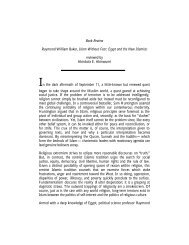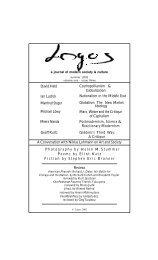Michael J. Thompson Stephen Eric Bronner Wadood Hamad - Logos
Michael J. Thompson Stephen Eric Bronner Wadood Hamad - Logos
Michael J. Thompson Stephen Eric Bronner Wadood Hamad - Logos
Create successful ePaper yourself
Turn your PDF publications into a flip-book with our unique Google optimized e-Paper software.
Stanley Aronowitz<br />
Power. The Power Elite, which appeared in 1956, more or less permanently<br />
consigns organized labor to a subordinate status within the pantheon of<br />
national power. In Mills’s view the moment had come and gone when unions<br />
could even conceive of making a qualitative difference in power arrangements.<br />
Whereas in 1948, Mills’s address was chiefly to the labor leaders themselves—<br />
it was both a careful sociological portrait of these new men of power and an<br />
attempted dialogue with them—the subsequent works do not have a specific<br />
labor public in mind.<br />
It was the theory of mass society, a concept that spans radical and conservative<br />
critiques of late capitalism, that informed Mills’s later pessimism. Mills was a<br />
leading figure in the sociology of “mass” culture and mass society which<br />
developed along several highly visible lines in the 1940s and 1950s. He<br />
observed the increasing homogenization of American culture and brilliantly<br />
linked some of its more egregious features to the decline of the democratic<br />
public. While his rhetoric was distinctly in the American vein, his views<br />
paralleled, and were crucially influenced by, those of Theodore Adorno, Max<br />
Horkheimer and Herbert Marcuse, the leading theorists of the Frankfurt<br />
school. While there is little evidence that he was similarly impressed by<br />
psychoanalysis, like them he linked cultural massification to mounting<br />
political conformity associated with the emergence of fascism and other<br />
authoritarian movements in nearly all advanced industrial societies.<br />
This pioneering study of the emergence of the middle class of salaried<br />
professional, technical and clerical employees situates the spread of mass culture<br />
after World War I to their growing significance in advanced industrial societies.<br />
Consistent with his emerging obsession with questions of political and social<br />
power and of the prospects for radical social transformation, White Collar may<br />
be read as an assessment not only of the occupational situation of the various<br />
strata of the middle class in the manner of traditional sociological analysis, but<br />
of the social psychology of what Mills terms the “new” middle class—the<br />
rapidly growing strata of salaried professional, technical and administrative<br />
employees—many of them working in large corporations. The book opens<br />
with an obituary of the “old” middle class—farmers, small merchants and<br />
manufacturers—perhaps the leading class of the 18th and first half of 19th<br />
century. The transformation of property from a welter of small independent<br />
producers and merchants to large concentrations of capital which marked the<br />
<strong>Logos</strong> 2.3 – Summer 2003




